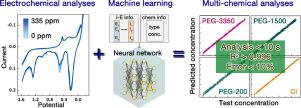Electrochimica Acta ( IF 6.6 ) Pub Date : 2021-10-15 , DOI: 10.1016/j.electacta.2021.139424 Young Yoon 1 , Myung Jun Kim 2 , Jae Jeong Kim 1

|
This study introduces the role of machine learning in improving the electrochemical analyses for the simultaneous quantifications of multiple chemicals. Here, Cu electrolyte containing Cl− and polyethylene glycol as additives was employed as a model analyte. These additives, which are redox-inactive when adsorbed onto the surface of an electrode, significantly affect Cu redox reactions. Conventional analyses cannot reveal the detailed dynamic changes in these additives owing to inherently weak signals and interference between the adsorbates. Thus, this study demonstrates how a combination of electrochemical analyses and neural network-based machine learning can identify and quantify four different additives from a single voltammogram, overcoming the present limitations. Further, instead of simply increasing the amount of data for training, chemical treatment is applied based on an understanding of Cu–adsorbate interactions to improve the performance of machine learning-based analyses. The developed method can also advance the simultaneous electrochemical analyses of other multicomponent systems.
中文翻译:

电化学的机器学习:分析铜电解质中的聚合物和卤化物离子
本研究介绍了机器学习在改进电化学分析以同时量化多种化学物质方面的作用。这里,含有Cl - 的Cu电解液聚乙二醇作为添加剂被用作模型分析物。这些添加剂在吸附到电极表面时是无氧化还原活性的,会显着影响铜氧化还原反应。由于固有的弱信号和吸附物之间的干扰,常规分析无法揭示这些添加剂的详细动态变化。因此,这项研究展示了电化学分析和基于神经网络的机器学习的组合如何从单个伏安图中识别和量化四种不同的添加剂,克服目前的局限性。此外,不是简单地增加用于训练的数据量,而是基于对 Cu-吸附物相互作用的理解来应用化学处理,以提高基于机器学习的分析的性能。



























 京公网安备 11010802027423号
京公网安备 11010802027423号